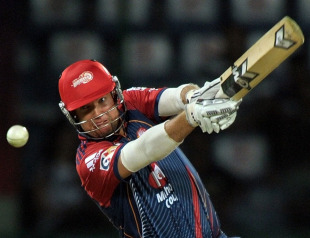Match facts
Thursday, May 12, Chennai
Start time 2000 (14.30 GMT)
Start time 2000 (14.30 GMT)

| ||
Big Picture
Chennai Super Kings are the team to beat in the IPL, yet again. Mumbai Indians may have done the early running and may be top of the table, but they have also twice collapsed dramatically for totals of less than 100. Contrastingly, it has taken either the elements or a special performance to conspire against Chennai, who are one of only two teams to have posted totals in excess of 180 on three occasions. With the ball, they have done just about enough to choke off opponents, which is evident from the fact that they have bowled out their opposition only once this season.
As if seven losses weren't enough, Delhi Daredevils now have to compete without Virender Sehwag, architect of three of their four wins so far, who willmiss the rest of the IPL to undergo shoulder surgery. Delhi with Sehwag were average, Delhi without Sehwag will be poor, unless they can manage to step up considerably under new captain James Hopes. Chennai have been unbeaten so far at home this season, and will start as clear favourites on Thursday. A win will mean a play-off berth is more or less secure.
Form guide (most recent first)
Chennai: WLWWW (third in points table)
Delhi: LWLWL (eighth in points table)
Delhi: LWLWL (eighth in points table)
Team talk
It is impossible to replace Sehwag, but someone will have to take his place in the XI. It could be young Unmukt Chand, who had two torrid outings at the start of the season. Roelof van der Merwe could also get a game, but that would mean Colin Ingram having to miss out after only one match, in which he faced two balls.
Chennai have grown stronger after the arrival of Dwayne Bravo but what Wriddhiman Saha's role was in the previous match is anybody's guess, considering that he didn't keep, and would have batted at No. 8. At least S Anirudha can bat higher up or Joginder Sharma can bowl.
In the spotlight
After starting this season with three half-centuries and a 46 in five matches, David Warner's form has tapered off sharply, with only 26 runs in his next five innings. He was even left out against Deccan Chargers, but in the absence of Sehwag, his position at the top of the order acquires added importance, if Delhi have to challenge Chennai.
That Doug Bollinger has a better economy rate than even R Ashwin, who is usually difficult to get away, shows how important the fast bowler has been for MS Dhoni. He has chugged in and hustled batsmen with pace, bounce, angle and variation, whether at the start of the innings or at the death. Thirteen wickets from just eight games have made Chennai even more reliant on him.
Prime numbers
- The highest total the in IPL is Chennai's 246 made in 2010; the highest this season is Delhi's 231
- Chennai have the best win-loss ratio in the IPL, 1.43
The chatter
"Irfan Pathan is a solid player and he will be given some more opportunities in the next three games."
Delhi coach Greg Shipperd backs his premier allrounder to come good
Delhi coach Greg Shipperd backs his premier allrounder to come good






